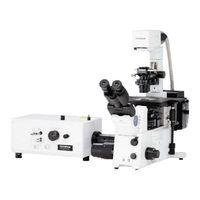Olympus FLUOVIEW FV300 Manuals
Manuals and User Guides for Olympus FLUOVIEW FV300. We have 2 Olympus FLUOVIEW FV300 manuals available for free PDF download: User Manual, Overview
Olympus FLUOVIEW FV300 User Manual (564 pages)
CONFOCAL LASER SCANNING
BIOLOGICAL MICROSCOPE
Brand: Olympus
|
Category: Microscope
|
Size: 17 MB
Table of Contents
Advertisement
Olympus FLUOVIEW FV300 Overview (16 pages)
CONFOCAL LASER SCANNING BIOLOGICAL MICROSCOPES
Brand: Olympus
|
Category: Microscope
|
Size: 2 MB

